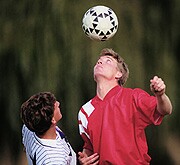
TUESDAY, June 11 (HealthDay News) — Sophisticated scans reveal that soccer players who head the ball a lot show changes in the white matter of their brain that mirror those seen in traumatic head injuries.
In addition, they face a higher risk of developing thinking and memory problems, the researchers report.
“We looked at the relationship between heading and changes in the brain and changes in cognitive functions [thinking and memory], and we found that the more heading people do, the more likely we are to find microscopic structural abnormalities in the brain, and they’re more likely to do poorly on cognitive tests, particularly in terms of memory,” said study author Dr. Michael Lipton, associate director of the Gruss Magnetic Resonance Research Center at Albert Einstein College of Medicine and medical director of magnetic resonance imaging at Montefiore Medical Center, both in New York City.
However, Lipton noted, “We cannot say heading caused these changes. We found an association, but in no way can we infer causation. You need a longitudinal study that follows people over time to prove causation.”
Results of the study were released online June 11 in the journal Radiology.
Soccer is the world’s most popular sport. More than 265 million people play the game worldwide, and heading is a common move in soccer. Heading a soccer ball means using your head instead of your feet to play the ball. In competitive games, players head the ball between an average of six and 12 times, according to background information in the study. In this elite level of play, the ball can travel at velocities of 50 miles per hour or more, according to the study.
This isn’t the first study to link heading and changes in the white matter in the brain. In an issue of the Journal of the American Medical Association late last year, Harvard researchers compared soccer players to swimmers, and found changes in the white matter in soccer players.
White matter is the communication network in the brain; it sends messages between neurons (gray matter).
For the current study, Lipton and his colleagues recruited 37 adult amateur soccer players. Their ages ranged from 21 to 44 years old, and the average age was nearly 31. Twenty-eight of the volunteers were men. They played at least one competitive game of soccer each week, and practiced an average of two times a week, according to Lipton. Most had been playing since they were kids.
All underwent a special imaging technique called diffusion tensor magnetic resonance imaging that produces detailed images that show microscopic changes in the white matter of the brain.
The players also filled out a questionnaire about such factors as frequency of heading and prior concussions, and completed a number of tests to measure their thinking and memory skills.
The researchers found that there appears to be a threshold for harm from heading. Below that threshold, there wasn’t as much risk, but there was significantly more risk of brain changes above it. In this study, the threshold was between 885 and 1,550 headers a year for brain changes, and higher than 1,800 headings a year for changes in memory scores.
Lipton said these findings were independent of past concussions.
“People can take some degree of trauma. Not everyone who bumps their head on a cabinet will have concussion symptoms. The question is how much does it take to have a lasting injury? And, that remains an open question, especially in children,” said Lipton.
Because kids’ brains are developing, they might be more susceptible to injuries, noted Lipton. But, on the other hand, he pointed out, children’s brains are also quite adaptable and can recover more easily from conditions such as stroke than adult brains can.
One expert noted that the study showed that even minor insults to the brain can have lasting effects.
“This study shows that even if you don’t have a concussion or a noticeable injury, if you look close enough at the brain, you can see changes. The evidence from these adults seems reasonably compelling that these minor heading events accumulate over time,” said Dr. Michael Bell, director of pediatric neurocritical care at Children’s Hospital of Pittsburgh.
For parents who may be wondering if they should keep their kids from heading soccer balls, Lipton said the evidence isn’t clear-cut enough yet to make a firm recommendation one way or the other.
“Parents have to weigh the evidence and make their own decisions. Our study provides very preliminary evidence that lines up with many of the concerns that parents have, but that needs to be balanced against the fact that this isn’t yet a closed book,” Lipton said.
Bell agreed, and added a counterpoint.
“The data is evolving, and any sort of mild traumatic brain injury may have consequences we don’t understand yet,” Bell said, adding that parents also have to remember that they don’t want to discourage their children from being physically active, because a sedentary lifestyle has other health risks.
More information
Learn more about mild brain injuries from the Brain Injury Association.

